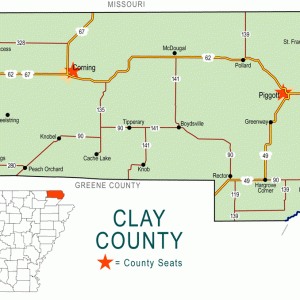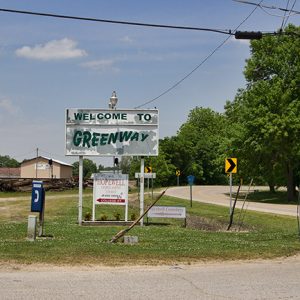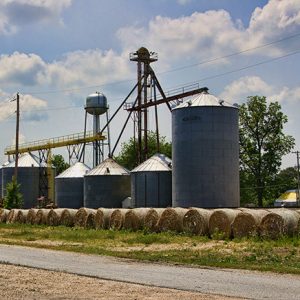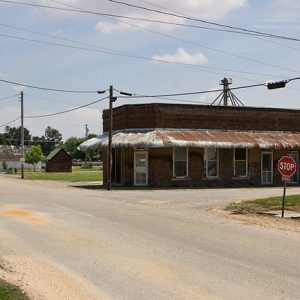calsfoundation@cals.org
Greenway (Clay County)
| Latitude and Longitude: | 36°20’28″N 090°13’13″W |
| Elevation: | 285 feet |
| Area: | 0.26 square miles (2020 Census) |
| Population: | 174 (2020 Census) |
| Incorporation Date: | March 13, 1886 |
Historical Population as per the U.S. Census:
|
1810 |
1820 |
1830 |
1840 |
1850 |
1860 |
1870 |
1880 |
1890 |
1900 |
|
– |
– |
– |
– |
– |
– |
– |
– |
33 |
165 |
|
1910 |
1920 |
1930 |
1940 |
1950 |
1960 |
1970 |
1980 |
1990 |
2000 |
|
390 |
362 |
367 |
303 |
288 |
179 |
240 |
317 |
212 |
244 |
|
2010 |
2020 |
|
|
|
|
|
|
|
|
|
209 |
174 |
|
|
|
|
|
|
|
|
Greenway is a city on U.S. Highway 49 in Clay County, three miles south of Piggott (Clay County). Built as a stop on the St. Louis and Texas Railroad, Greenway is one of the small agricultural centers of the Mississippi Delta region.
Frequently flooded by the Mississippi River and shaken by the New Madrid Earthquakes of 1811–1812, northeastern Arkansas remained sparsely settled until after the Civil War. The region consisted largely of swampland and hardwood forests, although a Military Road had been built across the region to link Missouri to Texas. Elihu and William Davis built a log cabin around 1837 in what would become the west side of Greenway, and a few other farming families also arrived and began clearing land on the eastern edge of Crowley’s Ridge. W. V. Turner, a physician, came in 1872 and built a house. In 1876, he persuaded the U.S. postal service to locate a post office in his house. Officially, the name of the post office was Clayville, to reflect the name of the county, but local residents preferred the name Hamburg. When the railroad was built in 1882, the depot was named Greenway, and the name of the post office was changed to Greenway the same year, though the source of the name has not been recorded.
In 1883, the Southwest Improvement Company (associated with the St. Louis and Texas Railroad) laid out a community to surround the depot. Greenway was incorporated in March 1886. By 1889, the city had four general stores, one drugstore, two groceries, one hardware and furniture store, one saloon, two sawmills, one stave factory, one schoolhouse, a Methodist church, a Baptist church, five physicians, and one attorney. Although the Goodspeed description of the city claims a population of 500 for Greenway at that time, official census records for 1890 show only thirty-three residents.
As in much of Clay County, Greenway benefited for a time from the booming timber industry. Canadian and British lumber companies established local headquarters in Greenway. Timber cutters labored six days a week and spent their money in Greenway on Saturday nights. As trees were removed, farmland was developed, and soon cotton was the dominant crop. Over time, soybeans, corn, and rice were also added as staple crops. The railroad changed hands several times, becoming the St. Louis Southwestern Railway, or Cotton Belt, before being acquired by the Southern Pacific Railroad in 1932 and eventually swallowed by the Union Pacific merger in 1996.
The Depression brought hard times to Greenway and to the farmers who lived around the city. By 1933, the city’s economic base had dwindled to three stores, two cafés, and a barbershop. Improvement of highways made it easy for people in and near Greenway to travel to Piggott or to Rector (Clay County) to shop and attend church services. Smaller schools like that of Greenway were consolidated into the Piggott school district.
In 2010, Greenway had a population of 209. Local businesses included a trucking firm and agricultural businesses, including a twenty-acre farm that raised organically grown pecans. By 2014, however, the pecan business had closed.
For additional information:
The Goodspeed Biographical and Historical Memoirs of Northeastern Arkansas. Chicago: Goodspeed Publishing Co., 1889.
Webb, Robert W. History and Traditions of Clay County. Mountain Home, AR: Shiras Bros. Print Shop, 1933.
Steven Teske
Butler Center for Arkansas Studies
 Clay County Map
Clay County Map  Greenway
Greenway  Greenway Silos
Greenway Silos  Greenway Neighborhood
Greenway Neighborhood  Greenway
Greenway 




Comments
No comments on this entry yet.